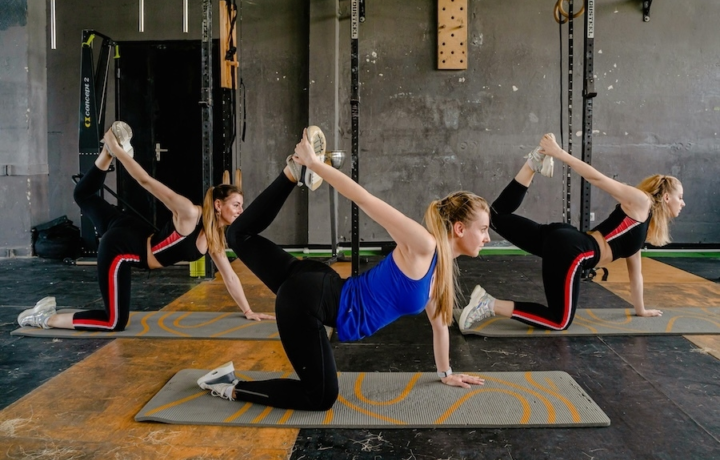Exercise
Seated Glute Stretch

Seated Glute Stretch
How to Perform
- Sit on the floor with your legs extended in front of you, and bend your right knee, placing your right foot on the outside of your left knee.
- Place your left elbow on the outside of your right knee, using it as leverage to gently rotate your torso to the right while keeping your spine straight.
- Position your right hand on the floor behind you for support, with fingers pointing away from your body to stabilize your upper body.
- Inhale deeply, and as you exhale, increase the rotation slightly by using your left arm against your right knee while maintaining a tall, upright posture.
- Hold this position for 20-30 seconds while breathing normally, focusing on relaxing deeper into the stretch with each exhale.
- Slowly return to the starting position and switch sides by extending your right leg and bending your left knee, placing your left foot outside your right knee.
- Position your right elbow against the outside of your left knee and place your left hand behind you, rotating your torso to the left while maintaining proper alignment.
- Complete the same duration on this side, ensuring you maintain equal tension and time on both sides for balanced flexibility development.
Important information
- Keep your sitting bones firmly grounded throughout the stretch to maximize glute engagement and prevent compensating with your lower back.
- If you feel discomfort in your knees, modify by keeping the bottom leg slightly bent rather than fully extended.
- Focus on rotating from your mid-back rather than forcing the movement through your shoulders or neck.
- Avoid bouncing or jerking movements during the stretch; instead, use your breath to gradually increase the range of motion.

Seated Glute Stretch
Exercise Details
Primary Muscles
Muscle Groups
Mechanic
Built for progress
Take the guesswork out of training
Create personalized AI-powered workout plans that evolve with you. Train smarter, track every rep and keep moving forward, one workout at a time.






The Seated Glute Stretch offers a gentle yet effective way to release tension in the buttocks, an area often overlooked during standard stretching routines. This beginner-friendly position targets the gluteal muscles—the powerhouse muscle group responsible for hip extension and rotation during everyday movements and athletic performance. When our glutes become tight from prolonged sitting, intense workouts, or simply daily activities, they can contribute to lower back pain, hamstring tightness, and even affect our walking gait. The beauty of this stretch lies in its accessibility, requiring no equipment and minimal space, making it perfect for both warm-up preparation and cool-down recovery protocols.
The stretch works by creating a controlled tension across the piriformis and deeper gluteal muscles, areas that can harbor significant tightness, especially in desk workers and athletes alike. Physiologically, holding this position allows the muscle fibers to gradually lengthen, increasing blood flow to the area while signaling the nervous system to permit greater range of motion. This makes the Seated Glute Stretch invaluable for mobility enhancement over time. For recovery purposes, this stretch helps flush metabolic waste products that accumulate during intense glute-focused exercises like squats, lunges, and deadlifts.
When used as part of a cool-down routine, it can potentially reduce post-workout soreness and speed up the recovery process. As a warm-up element, it prepares the hip complex for more dynamic movements by increasing tissue temperature and neural activation in the posterior chain.
The versatility of this stretch extends beyond just fitness applications. Many physical therapists recommend it for patients with sciatic nerve irritation, as stretching the piriformis (a small muscle that can sometimes compress the sciatic nerve) can provide significant relief. Whether you're an office worker needing midday relief, an athlete preparing for competition, or someone simply seeking to improve overall mobility, the Seated Glute Stretch deserves a permanent spot in your movement toolkit.
FAQ - Seated Glute Stretch
The Seated Glute Stretch primarily targets the gluteus maximus, medius, and minimus, along with the piriformis (a deep rotator muscle). It also indirectly stretches parts of the lower back and outer hip area.
For optimal results, hold the stretch for 20-30 seconds per side and repeat 2-3 times. If you're using it for recovery or have particularly tight glutes, you can extend the hold time to 45-60 seconds.
Yes, this stretch is often recommended for sciatic pain as it can help release the piriformis muscle, which sometimes compresses the sciatic nerve. However, perform it gently and stop immediately if you feel sharp pain rather than the normal stretching sensation.
The most common mistakes include rounding the lower back, forcing the stretch too aggressively, and not keeping the chest up. Make sure to maintain a neutral spine position and focus on feeling the stretch in the glute rather than straining to achieve a deeper position.
For optimal shoulder mobility, perform this stretch 1-2 times daily, especially if you spend long hours at a desk. Include it both as part of your pre-workout warm-up and post-workout recovery routine to maximize its benefits and progressively improve your overhead range of motion.






